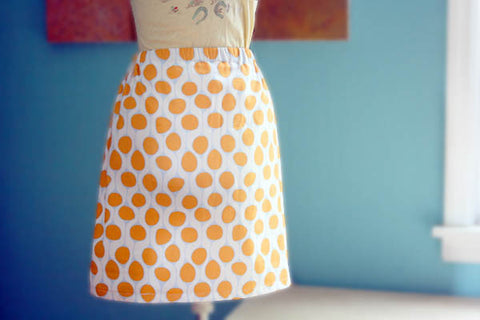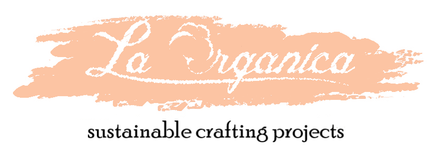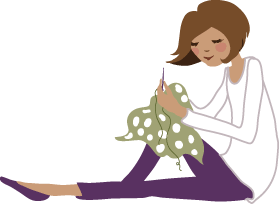 Make a Summer Skirt in 30 Minutes
Thursday, May 7 2015
Make a Summer Skirt in 30 Minutes
Thursday, May 7 2015
Creation: Quick and Easy Summer Skirt
Fabrics Used: Thirty-nine Sateen
The Visionary: Becky, Glueandglitter.com
Our Thoughts: Becky at Glueandglitter.com made a summer skirt using our Thirty-nine Sateen fabric from the Harmony Art collection. So quick and easy!
This elastic waist skirt takes about 30 minutes to make. Here’s how to make a skirt tailored to your measurements.

Summer is just around the corner, and what better way to round off your summer wardrobe than with a sweet little skirt?
I made this skirt out of Thirty-Nine Sateen, an organic cotton fabric by Harmony Art at Organic Cotton Plus. They also sent me their kelly green twill and a couple of yards of organic cotton twill tape. The latter is especially exciting, because I’ve had a hard time finding organic cotton tapes, and they’re so great for everything from using them as ribbon to finishing edges in projects.
I asked my contact at Organic Cotton Plus, Jeff, about their fabrics and their dye processes, and here’s what he had to say:
All of our production is done in accordance with the GOTS requirements, and we recently got our Warehouse certified to the standards! Almost everything we have in stock is fully certified right through packing, and as we move out old inventory, every yard of fabric will be to GOTS.
The dyes we use are “Fiber Reactive”-which are very eco-friendly and are approved by GOTS.
GOTS certification is the real deal when it comes to organic fabrics. If you want to learn more about what it means, check out my piece about GOTS certification at Crafting a Green World. Fiber reactive dyes are also much better from an environmental standpoint. They absorb into fabric very well, which means using less dye and it means less waste water.
How to Make an Elastic Waist Skirt
This elastic waist skirt took me about 30 minutes to make. It could take you a bit less time or a bit longer, depending on your skill level, but as making clothing goes it’s super duper simple. Here’s how to make your own elastic waist skirt tailored to your measurements.
Materials
1 yard of organic cotton fabric
1″ braided elastic
measuring tape
sewing machine, thread, scissors
2 safety pins
Directions
1. Measure your waist where you want the skirt to sit. That number is how much elastic you’ll need. Mine was 30″, so I cut a 30″ piece of 1″ braided elastic.
2. Measure the width around your torso around at the widest point – mine was around 40″. The width of your fabric needs to be this number plus 1″, so my fabric is 41″ wide.
3. Measure from your waist where you want the skirt to sit down to where you want the hem to fall. That number plus 2.5″ is how long your fabric piece needs to be. Mine was 20.5″ (I am high waisted), so my fabric was 23″ long. That means the fabric piece I’m cutting is 41″X23″.
4. Fold your fabric in half, right sides together to form the body of your skirt. My folded piece of fabric measures 20.5″ X 23″.
5. Sew up the side seam of your skirt using your machine’s zig zag stitch. Don’t forget to back stitch a few times at the top and bottom, so your seams will be strong.
6. Hem the bottom of your skirt. With the skirt still inside out, fold the bottom seam over by 1/2″, iron, then fold over again by 1/2″ to hide the unfinished seam. Use a straight or zig zag stitch to finish the seam.
I made this skirt out of Thirty-Nine Sateen, an organic cotton fabric by Harmony Art at Organic Cotton Plus. They also sent me their kelly green twill and a couple of yards of organic cotton twill tape. The latter is especially exciting, because I’ve had a hard time finding organic cotton tapes, and they’re so great for everything from using them as ribbon to finishing edges in projects.
I asked my contact at Organic Cotton Plus, Jeff, about their fabrics and their dye processes, and here’s what he had to say:
All of our production is done in accordance with the GOTS requirements, and we recently got our Warehouse certified to the standards! Almost everything we have in stock is fully certified right through packing, and as we move out old inventory, every yard of fabric will be to GOTS.
The dyes we use are “Fiber Reactive”-which are very eco-friendly and are approved by GOTS.
GOTS certification is the real deal when it comes to organic fabrics. If you want to learn more about what it means, check out my piece about GOTS certification at Crafting a Green World. Fiber reactive dyes are also much better from an environmental standpoint. They absorb into fabric very well, which means using less dye and it means less waste water.
How to Make an Elastic Waist Skirt
This elastic waist skirt took me about 30 minutes to make. It could take you a bit less time or a bit longer, depending on your skill level, but as making clothing goes it’s super duper simple. Here’s how to make your own elastic waist skirt tailored to your measurements.
Materials
1 yard of organic cotton fabric
1″ braided elastic
measuring tape
sewing machine, thread, scissors
2 safety pins
Directions
1. Measure your waist where you want the skirt to sit. That number is how much elastic you’ll need. Mine was 30″, so I cut a 30″ piece of 1″ braided elastic.
2. Measure the width around your torso around at the widest point – mine was around 40″. The width of your fabric needs to be this number plus 1″, so my fabric is 41″ wide.
3. Measure from your waist where you want the skirt to sit down to where you want the hem to fall. That number plus 2.5″ is how long your fabric piece needs to be. Mine was 20.5″ (I am high waisted), so my fabric was 23″ long. That means the fabric piece I’m cutting is 41″X23″.
4. Fold your fabric in half, right sides together to form the body of your skirt. My folded piece of fabric measures 20.5″ X 23″.
5. Sew up the side seam of your skirt using your machine’s zig zag stitch. Don’t forget to back stitch a few times at the top and bottom, so your seams will be strong.
6. Hem the bottom of your skirt. With the skirt still inside out, fold the bottom seam over by 1/2″, iron, then fold over again by 1/2″ to hide the unfinished seam. Use a straight or zig zag stitch to finish the seam.

7. Now, you’re going to make the tube for your elastic! Fold the top seam over by 1/2″ and iron, then use your machine to baste all the way around. Fold the seam over by another 1 1/8″, and sew almost all the way around, but leave yourself about a 2″ opening, so you can feed in the elastic. This tube you just sewed is called the casing, and it’s where you’ll feed the elastic through in the next step.

8. Grab your elastic and use the safety pin to attach one end to your skirt near the opening on the casing, then put the other safety pin on the other end of the elastic. Trust me, the safety pin makes it worlds easier. Now, just be patient as you work your elastic through opening in the casing, all the way around the skirt, and out the other side. Feel around and make sure your elastic isn’t twisted anywhere in the waistline, and straighten it out, if it is.
9. Overlap the two ends of the elastic by about 1/2″, then pin them together while they’re still sticking out of the opening in the casing. Use your machine’s zig zag stitch to sew the elastic band closed, then tuck it up into the casing.

10. Put your skirt back into the machine to sew that opening in the casing closed, flip your skirt right side out, arrange the fabric over the elastic, and give it one more press with the iron.
That’s it! You’re ready to rock your easy peasy elastic waist skirt!
0 Comments:

















 Same day shipping for most orders
Same day shipping for most orders Questions? Call us toll-free at: 1-855-SEW-PURE
Questions? Call us toll-free at: 1-855-SEW-PURE
